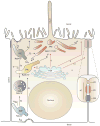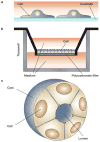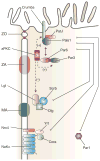Role of membrane traffic in the generation of epithelial cell asymmetry
- PMID: 23196841
- PMCID: PMC3771702
- DOI: 10.1038/ncb2635
Role of membrane traffic in the generation of epithelial cell asymmetry
Abstract
Epithelial cells have an apical-basolateral axis of polarity, which is required for epithelial functions including barrier formation, vectorial ion transport and sensory perception. Here we review what is known about the sorting signals, machineries and pathways that maintain this asymmetry, and how polarity proteins interface with membrane-trafficking pathways to generate membrane domains de novo. It is becoming apparent that membrane traffic does not simply reinforce polarity, but is critical for the generation of cortical epithelial cell asymmetry.
Conflict of interest statement
The authors declare no competing financial interests.
Figures




References
-
- Gassama-Diagne A, et al. Phosphatidylinositol-3,4,5-trisphosphate regulates the formation of the basolateral plasma membrane in epithelial cells. Nat Cell Biol. 2006;8:963–970. - PubMed
-
- Jacob R, Naim HY. Apical membrane proteins are transported in distinct vesicular carriers. Curr Biol. 2001;11:1444–1450. - PubMed
Publication types
MeSH terms
Grants and funding
LinkOut - more resources
Full Text Sources

